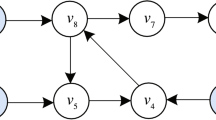Abstract
In this paper, the distributed average tracking (DAT) problem of a multi-agent system with input saturation is considered, whose objective is to make each agent track the average of a group of time-varying reference signals by local saturated inputs. This paper proposes two algorithms based on the techniques of low-gain feedback and nonsmooth feedback. The first algorithm considers reference signals without external inputs under the low-gain feedback scheme. We show that if the system matrix of the references is negative semi-definite, then the DAT error will be ultimately upper bounded. The other algorithm considers reference signals with bounded inputs, where the idea of nonsmooth feedback is employed. Finally, two simulation examples are presented to validate the theoretical results.



Similar content being viewed by others
References
Liu, J., Liu, Z.X., Chen, Z.Q.: Coordinative control of multi-agent systems using distributed nonlinear output regulation. Nonlinear Dyn. 67(3), 1871–1881 (2012)
Li, W.X., Chen, Z.Q., Liu, Z.X.: Leader-following formation control for second-order multiagent systems with time-varying delay and nonlinear dynamics. Nonlinear Dyn. 72(4), 803–812 (2013)
Ren, W., Beard, R.W.: Consensus seeking in multiagent systems under dynamically changing interaction topologies. IEEE Trans. Autom. Control 50(5), 655–661 (2005)
Liu, Z., Huang, X., Tan, X.D., Wang, H.: Distributed task migration for thermal hot spot reduction in many-core microprocessors. In: Proceedings of the 10th IEEE International Conference on ASIC, pp. 1–4 (2013)
Yang, P., Freeman, R.A., Lynch, K.M.: Multi-agent coordination by decentralized estimation and control. IEEE Trans. Autom. Control 53(11), 2480–2496 (2008)
Rahili, S., Ren, W.: Distributed continuous-time convex optimization with time-varying cost functions. IEEE Trans. Autom. Control 62, 1590–1605 (2016)
Zhu, M., Martnez, S.: Discrete-time dynamic average consensus. Automatica 46(2), 322–329 (2010)
Kia, S.S., Cortes, J., Martinez, S.: Singularly perturbed algorithms for dynamic average consensus. In: Proceedings of the 2013 European Control Conference, pp. 1758 –1763 (2013)
Nosrati, S., Shafiee, M., Menhaj, M.B.: Dynamic average consensus via nonlinear protocols. Automatica 48(9), 2262–2270 (2012)
Montijano, E., Montijano, J.I., Sagues, C., Martinez, S.: Robust discrete time dynamic average consensus. Automatica 50(12), 3131–3138 (2014)
Bai, H., Freeman, R.A., Lynch, K.M.: Robust dynamic average consensus of time-varying inputs. In: Proceedings of the 49th IEEE Conference on Decision and Control, pp. 3104–3109 (2010)
Montijano, E., Montijano, J.I., Sagues, C., Martinez, S.: Step size analysis in discrete-time dynamic average consensus. In: Proceedings of the 2014 American Control Conference, pp. 5127–5132 (2014)
Chen, F., Cao, Y., Ren, W.: Distributed average tracking of multiple time-varying reference signals with bounded derivatives. IEEE Trans. Autom. Control 57(12), 3169–3174 (2012)
Freeman, R.A., Yang, P., Lynch, K.M.: Stability and convergence properties of dynamic average consensus estimators. In: Proceedings of the 45th IEEE Conference on Decision and Control, pp. 338–343 (2006)
Nosrati, S., Shafiee, M., Menhaj, M.: Synthesis and analysis of robust dynamic linear protocols for dynamic average consensus estimators. IET Control Theory Appl. 3(11), 1499–1516 (2009)
Chen, F., Ren, W.: A connection between dynamic region-following formation control and distributed average tracking. IEEE Trans. Cybern. PP(99), 1–13 (2017)
Hu, T., Lin, Z.: Control Systems with Actuator Saturation: Analysis and Design. Springer, Berlin (2001)
Kapila, V., Grigoriadis, K.: Actuator Saturation Control. CRC Press, Boca Raton (2002)
Corradini, M.L., Cristofaro, A., Giannoni, F., Orlando, G.: Control Systems with Saturating Inputs: Analysis Tools and Advanced Design, vol. 424. Springer, Berlin (2012)
Zhang, H., Yan, H., Yang, F., Chen, Q.: Distributed average filtering for sensor networks with sensor saturation. IET Control Theory Appl. 7(6), 887–893 (2013)
Zhao, Z., Hong, Y., Lin, Z.: Semi-global output consensus of a group of linear systems in the presence of external disturbances and actuator saturation: an output regulation approach. Int. J. Robust Nonlinear Control 26, 1353–1375 (2015)
Chen, H.: Robust stabilization for a class of dynamic feedback uncertain nonholonomic mobile robots with input saturation. Int. J. Control Autom. Syst. 12(6), 1216–1224 (2014)
Chen, H., Wang, C., Liang, Z., Zhang, D., Zhang, H.: Robust practical stabilization of nonholonomic mobile robots based on visual servoing feedback with inputs saturation. Asian J. Control 16(3), 692–702 (2014)
Chen, H., Li, B., Zhang, B., Zhang, L.: Global finite-time partial stabilization for a class of nonholonomic mobile robots subject to input saturation. Int. J. Adv. Robot. Syst. 12(11), 159 (2015)
Akella, M.R., Valdivia, A., Kotamraju, G.R.: Velocity-free attitude controllers subject to actuator magnitude and rate saturations. J. Guid. Control Dyn. 28(4), 659–666 (2012)
Sontag, E.D., Sussmann, H.J.: Nonlinear output feedback design for linear systems with saturating controls. In: Proceedings of the 29th IEEE Conference on Decision and Control, vol. 6, pp. 3414–3416 (1990)
Sontag, E.D.: An algebraic approach to bounded controllability of linear systems. Int. J. Control 39(1), 181–188 (1984)
Lin, Z.: Low Gain Feedback, vol. 240. Springer, London (1998)
Khalil, H.K., Grizzle, J.: Nonlinear Systems, vol. 3. Prentice Hall, New Jersey (1996)
Zheng, K., Shen, T., Yao, Y.: Filippov solutions on a lipschitz continuous surface. In: Proceedings of the 27th Chinese Control Conference, pp. 577–581 (2008)
Cortes, J.: Discontinuous dynamical systems: a tutorial on solutions, nonsmooth analysis, and stability. IEEE Control Syst. Mag. 28(3), 36–73 (2009)
Author information
Authors and Affiliations
Corresponding author
Additional information
This work was supported in part by National Natural Science Foundation of China under Grant 61473240, National Natural Science Foundation of Fujian Province under Grant 2017J01119, and State Key Laboratory of Intelligent Control and Decision of Complex Systems.
Rights and permissions
About this article
Cite this article
Liu, H., Chen, F., Xiang, L. et al. Distributed average tracking with input saturation. Nonlinear Dyn 90, 2827–2839 (2017). https://doi.org/10.1007/s11071-017-3844-z
Received:
Accepted:
Published:
Issue Date:
DOI: https://doi.org/10.1007/s11071-017-3844-z




